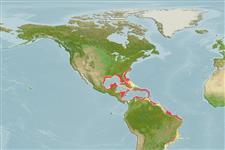Ircinia felix (Duchassaing & Michelotti, 1864)
Stinker sponge| Native range | All suitable habitat | Point map | Year 2050 |

|
| This map was computer-generated and has not yet been reviewed. |
| Ircinia felix AquaMaps Data sources: GBIF OBIS |
Upload your photos
Google image |
No photo available for this species.No drawings available for Irciniidae.
Google image |
No photo available for this species.
Classification / Names Common names | Synonyms | CoL | ITIS | WoRMS
Demospongiae | Dictyoceratida | Irciniidae
Environment: milieu / climate zone / depth range / distribution range Ecology
Sessile; brackish; depth range 1 - 100 m (Ref. 108813). Tropical; 25°C - 33°C (Ref. 86836)
Distribution Countries | FAO areas | Ecosystems | Occurrences | Introductions
Western Atlantic: Caribbean and Gulf of Mexico.
Length at first maturity / Size / Weight / Age
Maturity: Lm ? range ? - ? cm Max length : 0.2 cm H male/unsexed; (Ref. 415)
Short description Morphology
Variable growth forms: massive-amorphous, globular, thickly encrusting, flabellate or irregularly branching. Reddish-brown to grey externally; tan internally. Conulose surface: 0.1 - 0.2 cm cm high; 0.2 - 0.3 cm apart. Membrane-bearing oscules: 0.1 - 0.8 cm wide; with white or dark rims, scattered. Compressible; rubbery, extremely tough to be cut. Spicules absent (Ref. 415, 85482).
Common on mangroves (Ref. 415). Massive forms usually found on reefs; while branching and more lobate forms inhabit quieter shallow inshore hard bottoms, sediment and seagrass beds (Ref. 85482).
Life cycle and mating behavior Maturity | Reproduction | Spawning | Eggs | Fecundity | Larvae
Members of the class Demospongiae are hermaphroditic. Life cycle: The zygote develops into parenchymella larva (free-swimming) before settling down on a substrate where it grows into a young sponge.
Main reference
References | Coordinator | Collaborators
Collin, R., M.C. Díaz, J. Norenburg, R.M. Rocha, J.A. Sánchez, M. Schulze, A. Schwartz and A. Valdés. 2005. (Ref. 415)
IUCN Red List Status (Ref. 130435)
CITES status (Ref. 108899)
Not Evaluated
CMS (Ref. 116361)
Not Evaluated
Threat to humans
Human uses
| FishSource |
Tools
More information
Internet sources
BHL | BOLD Systems | CISTI | DiscoverLife | FAO(Publication : search) | Fishipedia | GenBank (genome, nucleotide) | GloBI | Gomexsi | Google Books | Google Scholar | Google | PubMed | Tree of Life | Wikipedia (Go, Search) | Zoological Record
Estimates based on models
Preferred temperature
(Ref. 115969): 22.5 - 28, mean 25.5 (based on 336 cells).
Price category
(Ref. 80766):
Unknown.


